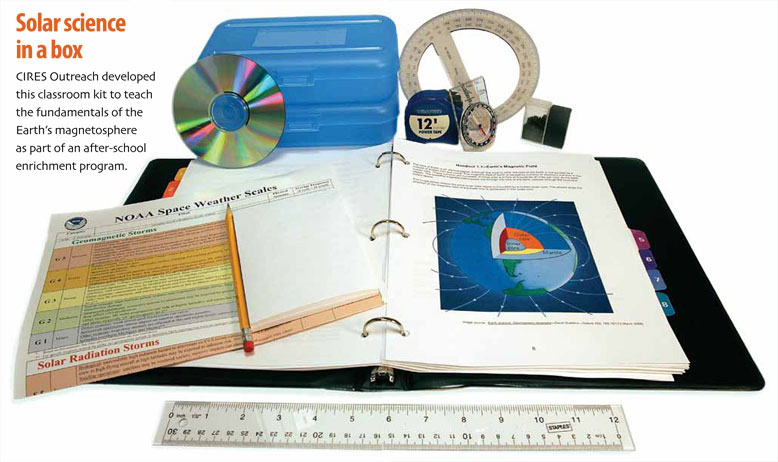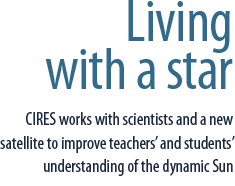Input: more leafy vegetation. Output: less rainfall?
To help support the SDO mission, CIRES has already supported workshops for teachers and developed an after-school program for diverse students. CIRES also helped to sponsor a workshop for science journalists at the Laboratory for Atmospheric and Space Physics (LASP) in Boulder, Colorado.
In the after-school program, which began focusing on Sun-Earth connections even before SDO’s launch, some students built antennas for their school roofs. The antennas pick up Sudden Ionospheric Disturbances, SIDs—changes that can occur when solar events impact the Earth’s ionosphere. Such data can be used as ground-truth for data collected by satellites such as SDO. “The kids learned a lot with the SIDs, especially how to handle real data,” said the teacher leading the class.
Through a NASA grant, CIRES Outreach also works with Stefan Maus and Susan McLean at NOAA’s Earth System Research Laboratory, offering after-school enrichment for high school students. Students learn about the origin of Earth’s magnetosphere; take a field trip to NOAA’s Space Weather Prediction Center in Boulder, Colorado; learn to navigate with magnetic compasses; and receive a visit from a researcher. ![]()
“Understanding solar variability is crucial,” added space scientist Judith Lean of the Naval Research Lab. “Our modern way of life depends upon it.”
CIRES Outreach is working on two projects to help people learn the modern importance of space weather, and to understand the basics of the Sun-Earth connections.
The first involves the Solar Dynamics Observatory (SDO) launched successfully February 11 from NASA’s Kennedy Space Center in Cape Canaveral, Florida. The NASA mission, to study solar variability, will “revolutionize our view of the Sun” said Lika Guhathakurta of NASA headquarters.
Tom Woods, lead scientist in charge of the Extreme Ultraviolet Variability Experiment (EVE) instrument on the SDO, said that the “trickle” of data scientists now get about the Sun is about to turn into a firehose of information streaming back to Earth every day.
CIRES Outreach works with the team that built EVE, which will measure variability in the extreme ultraviolet portion of the solar spectrum. Extreme ultraviolet radiation from the Sun ionizes the Earth’s upper atmosphere, affecting satellites, radio communication, and GPS navigation.
Imagine you are piloting an aircraft, and receive word you must alter your flight plan to avoid an extreme solar event, or your company’s production line suddenly shuts down as a power transformer 1,000 miles away sustains damage following a massive solar storm. Society is increasingly vulnerable to solar flares and the effects of solar weather: Our navigation, communication, and information systems all rely on a smooth flow of data from satellites and power from the grid.
“We are used to hearing that we live with a star, but we actually live within the Sun’s outer atmosphere,” said Sarah Gibson, a scientist with the National Center for Atmospheric Research High Altitude Observatory. People are affected by space weather just as we are affected by weather on the surface of the Earth, Gibson said during a workshop for journalists.




